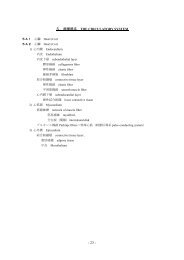Program / Abstract Book - KMU WWW3 Server for Education ...
Program / Abstract Book - KMU WWW3 Server for Education ...
Program / Abstract Book - KMU WWW3 Server for Education ...
Create successful ePaper yourself
Turn your PDF publications into a flip-book with our unique Google optimized e-Paper software.
No. 8 (PC 8)<br />
Development of the enzymatic method of serum ethanolamine and examination of<br />
its clinical utility<br />
E. Ohta (1) , E.Hokazono (1) , M.Ono (2) , T.Hotta (2) , S.Osawa (3) , Y.Kayamori (1)<br />
1<br />
Division of Medical Technology, Department of Health Sciences, Graduate school of<br />
Medicine, Kyushu University, 3-1-1 Maidashi, Higashi-ku, Fukuoka City, Japan<br />
2<br />
Department of Clinical Chemistry and Laboratory Medicine, Kyushu University<br />
Hospital, 3-1-1 Maidashi, Higashi-ku, Fukuoka City, Japan 3 Division of Clinical<br />
Laboratory Science, Department of Medical Risk And Crisis Management, Chiba<br />
Institute of Science, 15-8 Shiomi-cho, Choshi, Chiba, Japan<br />
Ethanolamine (EA) is mainly hydrolyzed from phosphatidyl ethanolamine (PE) by phospholipase D<br />
(PLD) in vivo. A study reported that urine EA increased in newborns as Zellweger syndrome, a<br />
congenital metabolic disease, but its concentration in blood and clinical significance in adults were not<br />
clarified. Recently, a metabolomics study using mass spectrometry reported that EA in saliva of<br />
pancreatic cancer patients increased significantly. There<strong>for</strong>e, our purposes are to develop a rapid and<br />
simple enzymatic method with an amine oxidase involving copper from Arthrobacter sp. (AAO) (EC<br />
1.4.3.6) and to examine the clinical meaning of EA in serum. In our measurement method, reagent 1<br />
(R-1) contained 0.1 mol/L HEPES buffer (pH 8.2 at 25ºC), 1.6 mmol/L TOOS, 5.0 kU/L POD, 1.12<br />
mmol/L N-ethylmaleimide, 16.8 kU/L L-ascorbate oxidase (ASOD) and 7.47 mmol/L NaN3. Reagent 2<br />
(R-2) contained 0.1 mol/L HEPES buffer (pH 8.2 at 25ºC), 20.0 kU/L AAO and 0.4 mmol/L<br />
4-aminoantipyrine. The assay used a Hitachi 7170 type analyzer. A 10 µL specimen was mixed with 180<br />
µL R-1; after incubation <strong>for</strong> 5 min at 37 ºC, 90 µL R-2 was added; after another 5 min, the mixture was<br />
measured using a 2-point end assay per<strong>for</strong>med at 37 ºC, with wavelengths of 700/546 (sub/main<br />
wavelength). The within-run CVs of the present method with three kinds of EA solutions ranged<br />
0.43-7.13% (n=10). The standard curve showed linearity from 0 to 800 µmol/L. Analytical recovery was<br />
98.4%. The reference interval of EA in normal was 8.17 ± 4.83 µmol/L (n=19). EA in hepatocellular<br />
carcinoma patient sera was significantly higher than normal. In conclusion, our method <strong>for</strong> serum EA is<br />
suitable <strong>for</strong> routine clinical use in the laboratory <strong>for</strong> determination of accuracy and simplicity. We<br />
consider EA in serum may be a new biomarker of hepatocellular carcinoma.<br />
- 61 -



